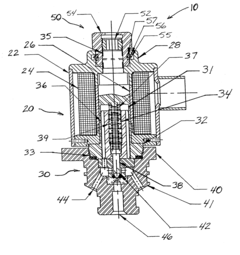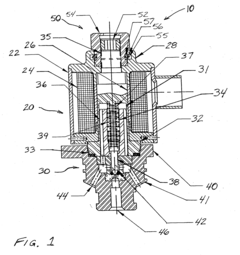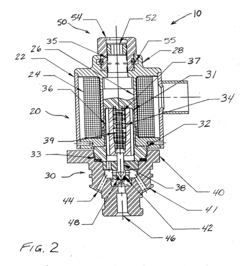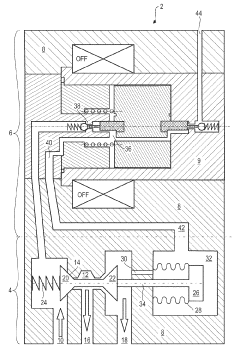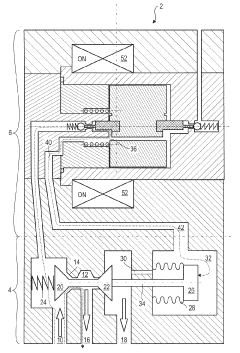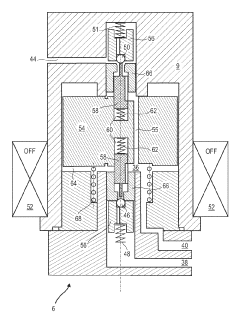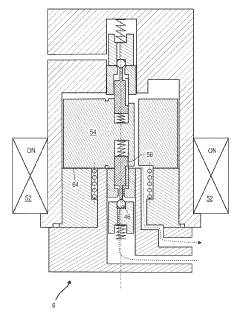Solenoid Valve Research for Microgravity Experiments in Space Missions
JUL 23, 20259 MIN READ
Generate Your Research Report Instantly with AI Agent
Patsnap Eureka helps you evaluate technical feasibility & market potential.
Space Solenoid Valve Background and Objectives
Solenoid valves have played a crucial role in space missions since the early days of space exploration. These electromechanical devices are essential for controlling the flow of fluids and gases in various spacecraft systems, including propulsion, life support, and scientific experiments. In the context of microgravity experiments, solenoid valves have become increasingly important as they enable precise control of fluid dynamics in the unique environment of space.
The development of solenoid valves for space applications has been driven by the need for reliable, compact, and efficient fluid control mechanisms that can operate in the harsh conditions of space. Early space missions relied on relatively simple valve designs, but as space technology has advanced, so too has the sophistication of solenoid valves used in spacecraft and space stations.
The primary objective of research on solenoid valves for microgravity experiments is to enhance their performance, reliability, and adaptability to the unique challenges posed by the space environment. This includes improving their resistance to extreme temperatures, radiation, and vacuum conditions, as well as minimizing power consumption and weight. Additionally, researchers aim to develop valves capable of precise control over a wide range of flow rates and pressures, which is critical for conducting accurate scientific experiments in microgravity.
Another key goal is to address the specific requirements of microgravity fluid dynamics. In the absence of gravity, fluids behave differently than they do on Earth, affecting phenomena such as surface tension, capillary action, and bubble formation. Solenoid valves designed for microgravity experiments must account for these unique behaviors to ensure accurate and repeatable results.
The evolution of solenoid valve technology for space applications has been marked by several significant milestones. These include the development of miniaturized valves for nanosatellites, the integration of smart materials for improved efficiency, and the implementation of advanced control systems for more precise operation. Recent advancements have also focused on creating multi-functional valves that can perform multiple tasks within a single unit, thereby reducing overall system complexity and weight.
Looking forward, the objectives for future solenoid valve research in space applications include further miniaturization, increased durability for long-duration missions, and the development of self-diagnostic and self-healing capabilities. There is also a growing interest in exploring novel actuation mechanisms, such as piezoelectric or shape memory alloy-based systems, which could offer advantages in terms of response time, power efficiency, and reliability.
As space exploration continues to expand, with ambitious plans for lunar bases, Mars missions, and deep space exploration, the demand for advanced solenoid valves will only increase. These devices will play a critical role in enabling complex scientific experiments, supporting life support systems, and facilitating in-situ resource utilization on other celestial bodies.
The development of solenoid valves for space applications has been driven by the need for reliable, compact, and efficient fluid control mechanisms that can operate in the harsh conditions of space. Early space missions relied on relatively simple valve designs, but as space technology has advanced, so too has the sophistication of solenoid valves used in spacecraft and space stations.
The primary objective of research on solenoid valves for microgravity experiments is to enhance their performance, reliability, and adaptability to the unique challenges posed by the space environment. This includes improving their resistance to extreme temperatures, radiation, and vacuum conditions, as well as minimizing power consumption and weight. Additionally, researchers aim to develop valves capable of precise control over a wide range of flow rates and pressures, which is critical for conducting accurate scientific experiments in microgravity.
Another key goal is to address the specific requirements of microgravity fluid dynamics. In the absence of gravity, fluids behave differently than they do on Earth, affecting phenomena such as surface tension, capillary action, and bubble formation. Solenoid valves designed for microgravity experiments must account for these unique behaviors to ensure accurate and repeatable results.
The evolution of solenoid valve technology for space applications has been marked by several significant milestones. These include the development of miniaturized valves for nanosatellites, the integration of smart materials for improved efficiency, and the implementation of advanced control systems for more precise operation. Recent advancements have also focused on creating multi-functional valves that can perform multiple tasks within a single unit, thereby reducing overall system complexity and weight.
Looking forward, the objectives for future solenoid valve research in space applications include further miniaturization, increased durability for long-duration missions, and the development of self-diagnostic and self-healing capabilities. There is also a growing interest in exploring novel actuation mechanisms, such as piezoelectric or shape memory alloy-based systems, which could offer advantages in terms of response time, power efficiency, and reliability.
As space exploration continues to expand, with ambitious plans for lunar bases, Mars missions, and deep space exploration, the demand for advanced solenoid valves will only increase. These devices will play a critical role in enabling complex scientific experiments, supporting life support systems, and facilitating in-situ resource utilization on other celestial bodies.
Microgravity Experiment Demand Analysis
The demand for microgravity experiments in space missions has been steadily increasing over the past decades, driven by the unique opportunities offered by the space environment for scientific research and technological advancements. Microgravity conditions provide an ideal setting for studying various physical, chemical, and biological phenomena that are otherwise masked or distorted by Earth's gravitational field.
In the context of solenoid valves for microgravity experiments, the market demand is primarily fueled by the need for precise fluid control systems in space-based research facilities. These valves play a crucial role in managing the flow of liquids and gases in experimental setups, ensuring accurate and repeatable results in microgravity conditions.
The International Space Station (ISS) serves as a primary platform for microgravity research, hosting numerous experiments that require sophisticated fluid handling systems. The demand for solenoid valves in this environment is driven by the need for compact, lightweight, and highly reliable components that can withstand the rigors of space travel and operate flawlessly in microgravity.
Beyond the ISS, there is a growing interest in microgravity research from commercial space companies and emerging space nations. This expansion of space activities is expected to further increase the demand for specialized equipment, including advanced solenoid valves, for microgravity experiments.
The pharmaceutical and biotechnology industries have shown particular interest in microgravity research, as it offers unique insights into protein crystallization, cell behavior, and drug development. This has created a niche market for solenoid valves designed specifically for life science experiments in space.
Materials science is another field driving the demand for microgravity experiments. Researchers are exploring the potential of manufacturing high-quality crystals, alloys, and other materials in space, which requires precise control over fluid dynamics and thermal conditions. Solenoid valves are essential components in these experimental setups, controlling the flow of raw materials and coolants.
The growing trend of miniaturization in space technology is also influencing the demand for solenoid valves. There is an increasing need for smaller, more efficient valves that can be integrated into compact experimental modules and CubeSats, allowing for more diverse and frequent microgravity experiments.
As space agencies and private companies plan for long-duration missions to the Moon and Mars, the demand for reliable life support systems and in-situ resource utilization technologies is rising. Solenoid valves will play a critical role in these systems, managing the flow of air, water, and other vital resources in microgravity and partial gravity environments.
In the context of solenoid valves for microgravity experiments, the market demand is primarily fueled by the need for precise fluid control systems in space-based research facilities. These valves play a crucial role in managing the flow of liquids and gases in experimental setups, ensuring accurate and repeatable results in microgravity conditions.
The International Space Station (ISS) serves as a primary platform for microgravity research, hosting numerous experiments that require sophisticated fluid handling systems. The demand for solenoid valves in this environment is driven by the need for compact, lightweight, and highly reliable components that can withstand the rigors of space travel and operate flawlessly in microgravity.
Beyond the ISS, there is a growing interest in microgravity research from commercial space companies and emerging space nations. This expansion of space activities is expected to further increase the demand for specialized equipment, including advanced solenoid valves, for microgravity experiments.
The pharmaceutical and biotechnology industries have shown particular interest in microgravity research, as it offers unique insights into protein crystallization, cell behavior, and drug development. This has created a niche market for solenoid valves designed specifically for life science experiments in space.
Materials science is another field driving the demand for microgravity experiments. Researchers are exploring the potential of manufacturing high-quality crystals, alloys, and other materials in space, which requires precise control over fluid dynamics and thermal conditions. Solenoid valves are essential components in these experimental setups, controlling the flow of raw materials and coolants.
The growing trend of miniaturization in space technology is also influencing the demand for solenoid valves. There is an increasing need for smaller, more efficient valves that can be integrated into compact experimental modules and CubeSats, allowing for more diverse and frequent microgravity experiments.
As space agencies and private companies plan for long-duration missions to the Moon and Mars, the demand for reliable life support systems and in-situ resource utilization technologies is rising. Solenoid valves will play a critical role in these systems, managing the flow of air, water, and other vital resources in microgravity and partial gravity environments.
Solenoid Valve Technology in Space: Current Status and Challenges
Solenoid valves play a crucial role in microgravity experiments conducted during space missions. These electromechanical devices are essential for controlling fluid flow in various systems, including life support, propulsion, and scientific research equipment. However, the unique environment of space presents significant challenges for the design and operation of solenoid valves.
Currently, solenoid valve technology for space applications has reached a high level of sophistication. Manufacturers have developed specialized valves capable of withstanding the extreme conditions encountered during space flight, including intense vibrations during launch, extreme temperature fluctuations, and prolonged exposure to vacuum. These valves are engineered to maintain reliable performance while minimizing power consumption and weight, two critical factors in space missions.
Despite these advancements, several challenges persist in the field of solenoid valve technology for space applications. One of the primary concerns is the long-term reliability of these components. Space missions often span several years, and the valves must operate flawlessly throughout this period with minimal maintenance. Ensuring consistent performance over extended periods in the harsh space environment remains a significant technical hurdle.
Another challenge is the need for increased miniaturization without compromising functionality. As space experiments become more complex and diverse, there is a growing demand for smaller, lighter valves that can be integrated into compact experimental setups. This miniaturization effort must balance size reduction with the ability to maintain precise flow control and withstand the rigors of space travel.
The microgravity environment itself poses unique challenges for solenoid valve operation. In the absence of gravity, fluid behavior changes significantly, affecting flow patterns and potentially impacting valve performance. Engineers must account for these altered fluid dynamics when designing valves for space applications, often requiring innovative solutions to ensure accurate and repeatable fluid control.
Radiation exposure is another critical concern for solenoid valves in space. Prolonged exposure to cosmic radiation can degrade electronic components and materials, potentially leading to valve failure. Developing radiation-hardened solenoid valves or implementing effective shielding strategies is an ongoing area of research and development in the field.
Furthermore, the extreme temperature variations encountered in space necessitate the use of specialized materials and thermal management techniques. Solenoid valves must operate reliably in both the extreme cold of deep space and the high temperatures experienced during solar exposure. This wide temperature range places significant demands on the materials used in valve construction and the overall design of the valve system.
In conclusion, while solenoid valve technology for space applications has made significant strides, there remain several challenges to overcome. Addressing these issues will require continued innovation in materials science, design methodologies, and manufacturing techniques to produce valves that meet the exacting requirements of microgravity experiments in space missions.
Currently, solenoid valve technology for space applications has reached a high level of sophistication. Manufacturers have developed specialized valves capable of withstanding the extreme conditions encountered during space flight, including intense vibrations during launch, extreme temperature fluctuations, and prolonged exposure to vacuum. These valves are engineered to maintain reliable performance while minimizing power consumption and weight, two critical factors in space missions.
Despite these advancements, several challenges persist in the field of solenoid valve technology for space applications. One of the primary concerns is the long-term reliability of these components. Space missions often span several years, and the valves must operate flawlessly throughout this period with minimal maintenance. Ensuring consistent performance over extended periods in the harsh space environment remains a significant technical hurdle.
Another challenge is the need for increased miniaturization without compromising functionality. As space experiments become more complex and diverse, there is a growing demand for smaller, lighter valves that can be integrated into compact experimental setups. This miniaturization effort must balance size reduction with the ability to maintain precise flow control and withstand the rigors of space travel.
The microgravity environment itself poses unique challenges for solenoid valve operation. In the absence of gravity, fluid behavior changes significantly, affecting flow patterns and potentially impacting valve performance. Engineers must account for these altered fluid dynamics when designing valves for space applications, often requiring innovative solutions to ensure accurate and repeatable fluid control.
Radiation exposure is another critical concern for solenoid valves in space. Prolonged exposure to cosmic radiation can degrade electronic components and materials, potentially leading to valve failure. Developing radiation-hardened solenoid valves or implementing effective shielding strategies is an ongoing area of research and development in the field.
Furthermore, the extreme temperature variations encountered in space necessitate the use of specialized materials and thermal management techniques. Solenoid valves must operate reliably in both the extreme cold of deep space and the high temperatures experienced during solar exposure. This wide temperature range places significant demands on the materials used in valve construction and the overall design of the valve system.
In conclusion, while solenoid valve technology for space applications has made significant strides, there remain several challenges to overcome. Addressing these issues will require continued innovation in materials science, design methodologies, and manufacturing techniques to produce valves that meet the exacting requirements of microgravity experiments in space missions.
Existing Solenoid Valve Solutions for Microgravity Environments
01 Solenoid valve design improvements
Various design improvements have been made to solenoid valves to enhance their performance and reliability. These include optimizing the valve body structure, improving the plunger mechanism, and incorporating advanced sealing technologies. Such enhancements result in better flow control, reduced leakage, and increased durability of the valve.- Solenoid valve design improvements: Various design improvements have been made to solenoid valves to enhance their performance and reliability. These include optimizing the valve body structure, improving the plunger mechanism, and incorporating advanced sealing technologies. Such enhancements result in better flow control, reduced leakage, and increased operational efficiency.
- Electronic control systems for solenoid valves: Advanced electronic control systems have been developed for solenoid valves, enabling precise regulation of fluid flow. These systems often incorporate microprocessors, sensors, and sophisticated algorithms to optimize valve operation. Features may include adaptive control, predictive maintenance, and remote monitoring capabilities.
- Energy-efficient solenoid valve designs: Innovations in solenoid valve design have focused on improving energy efficiency. This includes the development of low-power consumption coils, energy-saving actuation mechanisms, and smart power management systems. These advancements help reduce operational costs and environmental impact.
- Miniaturization of solenoid valves: Efforts have been made to miniaturize solenoid valves while maintaining or improving their performance. This involves innovative designs that reduce the overall size and weight of the valve components. Miniaturized solenoid valves find applications in space-constrained environments and portable systems.
- Solenoid valve materials and manufacturing techniques: Advancements in materials science and manufacturing techniques have led to improvements in solenoid valve construction. This includes the use of corrosion-resistant alloys, high-performance polymers, and advanced coating technologies. Novel manufacturing methods, such as 3D printing and precision machining, have also been employed to produce complex valve geometries and enhance overall quality.
02 Electronic control systems for solenoid valves
Advanced electronic control systems have been developed for solenoid valves, allowing for precise regulation of fluid flow. These systems may include microprocessors, sensors, and feedback mechanisms to adjust valve operation in real-time. This results in improved efficiency, accuracy, and adaptability to various operating conditions.Expand Specific Solutions03 Energy-efficient solenoid valve designs
Efforts have been made to create more energy-efficient solenoid valve designs. These innovations focus on reducing power consumption during operation, optimizing the electromagnetic coil design, and implementing power-saving modes. Such improvements lead to lower operating costs and increased sustainability in various applications.Expand Specific Solutions04 Miniaturization of solenoid valves
Advancements in manufacturing techniques and materials have enabled the miniaturization of solenoid valves. These compact designs maintain performance while reducing overall size and weight, making them suitable for space-constrained applications in industries such as automotive, medical, and aerospace.Expand Specific Solutions05 Multi-functional solenoid valve systems
Innovative multi-functional solenoid valve systems have been developed to combine multiple operations in a single unit. These integrated designs may incorporate features such as flow control, pressure regulation, and directional control. Such systems offer space savings, reduced complexity, and improved overall system efficiency in various fluid control applications.Expand Specific Solutions
Key Players in Space-grade Solenoid Valve Manufacturing
The research on solenoid valves for microgravity experiments in space missions is in a developing stage, with a growing market driven by increased space exploration activities. The technology's maturity varies among key players, with established companies like Robert Bosch GmbH and Samsung Electronics Co., Ltd. leading in innovation. Research institutions such as the Institute of Mechanics, Chinese Academy of Sciences, and Shanghai Institute of Aerospace Systems Engineering are contributing significantly to advancements. Specialized aerospace companies like Safran Aero Boosters NV and Xian Aerospace Power Research Institute are also making notable progress. The competitive landscape is diverse, including both traditional industrial giants and space-focused entities, indicating a dynamic and evolving field with potential for further growth and technological breakthroughs.
Robert Bosch GmbH
Technical Solution: Bosch has applied its automotive and industrial expertise to develop solenoid valves suitable for microgravity experiments. Their valves feature high-precision manufacturing techniques and advanced materials to ensure consistent performance in space conditions. Bosch's design incorporates smart control systems that allow for adaptive operation based on environmental changes. The valves use specialized coatings to minimize friction and wear, extending operational life in space. Bosch has also implemented energy-efficient actuation mechanisms to reduce power demands on spacecraft systems[4][6].
Strengths: Extensive experience in precision engineering, robust quality control processes. Weaknesses: May have less specific space industry experience compared to dedicated aerospace companies.
Parker-Hannifin Corp.
Technical Solution: Parker-Hannifin has leveraged its aerospace experience to develop solenoid valves for microgravity experiments. Their valves feature advanced materials such as titanium alloys to reduce weight while maintaining structural integrity. Parker's design incorporates multi-functional valve assemblies that combine flow control, pressure regulation, and filtration in a single unit, optimizing space utilization. The company has implemented specialized actuation mechanisms that provide precise control even with the minimal pressure differentials encountered in microgravity. Parker's valves also feature advanced thermal management systems to maintain consistent performance across varying temperature conditions in space[9][10].
Strengths: Comprehensive aerospace industry experience, integrated systems approach. Weaknesses: Potentially higher costs due to specialized aerospace-grade components and materials.
Core Innovations in Space-grade Solenoid Valve Technology
Solenoid valve for use in micro-gravity
PatentInactiveUS20030168620A1
Innovation
- A solenoid valve design featuring a fastening device that retains the electromagnetic solenoid assembly when uncoupled, combined with resilient sealing elements and spring elements to ensure secure coupling and zero or near-zero leakage, using a valve body with a valve seat surface and a movable valve element biased by springs to maintain sealing under high pressure and vibration.
Solenoid valve for low temperature high pressure steam for spacecraft launch device
PatentActiveJP2016217536A
Innovation
- A solenoid valve design featuring two valve seats, a passageway connecting them, and a magnetic circuit with a tappet driven by magnetic flux, allowing controlled displacement of stoppers relative to their seats, decoupling the plunger from the stopper to manage forces and maintain airtightness.
Space Mission Reliability and Safety Considerations
Space missions present unique challenges for equipment reliability and safety, particularly for critical components like solenoid valves used in microgravity experiments. The harsh space environment, characterized by extreme temperatures, radiation, and vacuum conditions, demands robust design and rigorous testing protocols to ensure the longevity and proper functioning of these valves throughout the mission duration.
Reliability in space missions is paramount, as equipment failures can lead to costly mission aborts or compromised scientific objectives. Solenoid valves must demonstrate exceptional durability and resistance to wear, as maintenance or replacement is often impossible once deployed. Manufacturers employ advanced materials and coatings to mitigate issues such as cold welding, outgassing, and thermal expansion, which can cause valve malfunction in space conditions.
Safety considerations for solenoid valves in space missions extend beyond their primary function. These components must not pose risks to astronauts, other equipment, or the spacecraft itself. This includes ensuring that the valves do not release harmful particles or gases, do not create electromagnetic interference with other systems, and can operate safely in the presence of various propellants and experimental fluids used in microgravity research.
Redundancy is a key strategy in enhancing both reliability and safety. Critical systems often incorporate backup valves or alternative flow paths to maintain functionality in case of primary valve failure. Additionally, fail-safe designs are implemented to ensure that valve malfunctions do not lead to catastrophic consequences for the mission or crew.
Extensive pre-flight testing and qualification procedures are essential to verify the reliability and safety of solenoid valves for space use. These tests simulate the extreme conditions of space, including thermal cycling, vibration testing, and long-duration operation in vacuum chambers. Accelerated life testing helps predict long-term performance and identify potential failure modes before deployment.
The integration of smart diagnostics and health monitoring systems into solenoid valves is an emerging trend that further enhances reliability and safety. These systems can provide real-time data on valve performance, allowing ground controllers to anticipate and potentially prevent failures before they occur. This proactive approach to maintenance and troubleshooting is particularly valuable for extended space missions where traditional servicing is not feasible.
Standardization efforts across space agencies and industry partners aim to establish common reliability and safety benchmarks for critical components like solenoid valves. These initiatives facilitate knowledge sharing, improve overall system compatibility, and streamline the qualification process for new technologies, ultimately contributing to safer and more reliable space missions.
Reliability in space missions is paramount, as equipment failures can lead to costly mission aborts or compromised scientific objectives. Solenoid valves must demonstrate exceptional durability and resistance to wear, as maintenance or replacement is often impossible once deployed. Manufacturers employ advanced materials and coatings to mitigate issues such as cold welding, outgassing, and thermal expansion, which can cause valve malfunction in space conditions.
Safety considerations for solenoid valves in space missions extend beyond their primary function. These components must not pose risks to astronauts, other equipment, or the spacecraft itself. This includes ensuring that the valves do not release harmful particles or gases, do not create electromagnetic interference with other systems, and can operate safely in the presence of various propellants and experimental fluids used in microgravity research.
Redundancy is a key strategy in enhancing both reliability and safety. Critical systems often incorporate backup valves or alternative flow paths to maintain functionality in case of primary valve failure. Additionally, fail-safe designs are implemented to ensure that valve malfunctions do not lead to catastrophic consequences for the mission or crew.
Extensive pre-flight testing and qualification procedures are essential to verify the reliability and safety of solenoid valves for space use. These tests simulate the extreme conditions of space, including thermal cycling, vibration testing, and long-duration operation in vacuum chambers. Accelerated life testing helps predict long-term performance and identify potential failure modes before deployment.
The integration of smart diagnostics and health monitoring systems into solenoid valves is an emerging trend that further enhances reliability and safety. These systems can provide real-time data on valve performance, allowing ground controllers to anticipate and potentially prevent failures before they occur. This proactive approach to maintenance and troubleshooting is particularly valuable for extended space missions where traditional servicing is not feasible.
Standardization efforts across space agencies and industry partners aim to establish common reliability and safety benchmarks for critical components like solenoid valves. These initiatives facilitate knowledge sharing, improve overall system compatibility, and streamline the qualification process for new technologies, ultimately contributing to safer and more reliable space missions.
Environmental Impact of Space-grade Valve Materials
The environmental impact of space-grade valve materials used in solenoid valves for microgravity experiments is a critical consideration in space missions. These materials must withstand extreme conditions while minimizing their ecological footprint both in space and on Earth. The production, use, and disposal of these specialized materials can have significant environmental implications.
Space-grade valve materials often include high-performance alloys, such as titanium, stainless steel, and nickel-based superalloys. While these materials offer excellent durability and resistance to corrosion, their manufacturing processes can be energy-intensive and generate substantial greenhouse gas emissions. The extraction and refining of rare earth elements, often used in these alloys, can lead to environmental degradation and pollution in mining areas.
In space, the primary environmental concern is the potential for material degradation and the release of particles or gases that could contaminate the spacecraft's atmosphere or sensitive experimental equipment. Space-grade materials are designed to minimize outgassing, but long-term exposure to radiation and temperature fluctuations may still result in some material breakdown. This necessitates careful selection and testing of materials to ensure minimal environmental impact during extended space missions.
The disposal of space-grade valve materials at the end of their lifecycle presents another environmental challenge. Many of these materials are not biodegradable and may contain hazardous substances. Proper recycling and disposal methods must be developed to prevent these materials from contributing to space debris or causing harm if they re-enter Earth's atmosphere.
On Earth, the testing and qualification of space-grade valve materials often involve the use of specialized facilities and equipment. These processes can consume significant amounts of energy and resources. However, advancements in simulation technologies and more efficient testing methods are helping to reduce the environmental impact of these necessary procedures.
The space industry is increasingly focusing on developing more environmentally friendly materials for valve components. This includes research into bio-based polymers, recyclable composites, and materials with lower embodied energy. These efforts aim to reduce the overall environmental footprint of space missions while maintaining the high performance standards required for microgravity experiments.
Space-grade valve materials often include high-performance alloys, such as titanium, stainless steel, and nickel-based superalloys. While these materials offer excellent durability and resistance to corrosion, their manufacturing processes can be energy-intensive and generate substantial greenhouse gas emissions. The extraction and refining of rare earth elements, often used in these alloys, can lead to environmental degradation and pollution in mining areas.
In space, the primary environmental concern is the potential for material degradation and the release of particles or gases that could contaminate the spacecraft's atmosphere or sensitive experimental equipment. Space-grade materials are designed to minimize outgassing, but long-term exposure to radiation and temperature fluctuations may still result in some material breakdown. This necessitates careful selection and testing of materials to ensure minimal environmental impact during extended space missions.
The disposal of space-grade valve materials at the end of their lifecycle presents another environmental challenge. Many of these materials are not biodegradable and may contain hazardous substances. Proper recycling and disposal methods must be developed to prevent these materials from contributing to space debris or causing harm if they re-enter Earth's atmosphere.
On Earth, the testing and qualification of space-grade valve materials often involve the use of specialized facilities and equipment. These processes can consume significant amounts of energy and resources. However, advancements in simulation technologies and more efficient testing methods are helping to reduce the environmental impact of these necessary procedures.
The space industry is increasingly focusing on developing more environmentally friendly materials for valve components. This includes research into bio-based polymers, recyclable composites, and materials with lower embodied energy. These efforts aim to reduce the overall environmental footprint of space missions while maintaining the high performance standards required for microgravity experiments.
Unlock deeper insights with Patsnap Eureka Quick Research — get a full tech report to explore trends and direct your research. Try now!
Generate Your Research Report Instantly with AI Agent
Supercharge your innovation with Patsnap Eureka AI Agent Platform!
